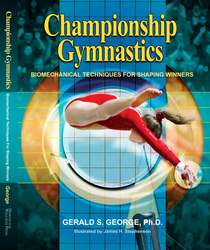|

___________________________________________________________
|
|
|
|
|
|
Gymnastics Technique: 
Factors Affecting Success
Part 4
by Gerald S. George, Ph.D.
January 21, 2013
|
A number of important training concepts directly influence:
- the rate of progress
- the quality of skill execution
- the resulting degree of success
- and the assurance of a reasonable margin of safety
that one can ultimately hope to achieve in gymnastics. Here are some of the more time-tested factors to consider. Part 4 of a 4-part series.
If you missed Part 1, CLICK HERE
If you missed Part 2, CLICK HERE
|
|
|
|
|
|
In artistic gymnastics, sureness of execution is the degree to which the gymnast demonstrates absolute command of her performance. This concept seeks to define how the story of movement technique is to be told. For success is not simply a matter of executing skills in a technically correct fashion--rather, it is the level of sureness in technical excellence brought to the performance which determines the ultimate champion.
The concept of sureness applies to virtually all skills in all gymnastics events. The vaulter who lands without hopping or taking a step, yet tentatively wobbles, will never outscore the vaulter who stretches for the ground and "sticks" the landing like a dart! And what about the gymnast who, in performing a release-grip skill on the unevens, finds the bar slamming into her hands as opposed to her reaching for and confidently re-grasping the bar? The same can be said of the beam performer who displays technical excellence in a leap but does so with an air of uncertainty. In tumbling, landings are particularly vulnerable to scrutiny of "sureness," in that they often appear to come as a surprise to the performer rather than as a "command performance"! Simply put, sureness of execution deals with the overall impression created in the mind's eye of the judges by the given performance. Keep in mind:
Judges are not impressed with luck, only skill.
|
|
Psychological Readiness--The Ultimate Domain
|
Success in gymnastics is really no different from success in any other sports endeavor. First and foremost, performers must possess the requisite physical capabilities to meet the demands of the gymnastics activity. This aspect, often referred to as "physiological readiness," is similar to designing the engine for an Indy 500 race car. Without first ensuring a sufficient performance source, the best-laid plans of mice and men lie dormant. And yet a finely tuned, high-powered engine is of limited value without the proper transmission to deliver its raw power effectively to the road. In terms of gymnastics success, the correct mechanical techniques must be applied to optimize skill execution. In other words, "biomechanical readiness" serves as the gymnast's transmission when it comes to "where the rubber meets the road." Virtually all elite-level gymnastics competitors possess high levels of both physiological and biomechanical readiness. Consequently, the margin for victory is almost always based on "least-discernible differences." More often than not, one finds that mere hundredths of a point separate the champion from the would-be champion. So wherein lies the ultimate difference? The difference is found in the ultimate domain, "psychological readiness"--the degree to which the performer is mentally and emotionally prepared to demonstrate absolute command of the performance. It deals with, among other things, a performer's perceptions, self-image, attitude, and work ethic. Learning how to cope effectively with fear, anxiety, onlookers, and the competitive setting are typical examples accounting for the least-discernible differences at the elite level. Psychological readiness is a success-oriented mind-set allowing the gymnast to ignore all extraneous variables that can negatively affect performance in favor of the ability to focus clearly and only on the task at hand. And this ability is, without question, the ultimate key to giving one's very best effort. Winning is simply giving the very best you have to offer.
*This article excerpted from Championship Gymnastics: Biomechanical Techniques for Shaping Winners. For additional information, see Chapter 1, "Introduction to Gymnastics Technique."
|
"Championship Gymnastics" -- Featuring 140 Gymnastic Illustrations
Called "A True Masterpiece" by International Gymnast Magazine
Currently Used In 38 Countries Worldwide! |   140 Illustrations Show You the Exact Positions and Movements for Achieving Success and Shaping Championship Winners. 140 Illustrations Show You the Exact Positions and Movements for Achieving Success and Shaping Championship Winners.
Rather than laboring on complex physics formulas, fundamental principles of biomechanics are clearly explained and presented in layman's terms.
Easy to read and expertly illustrated, readers are guided effortlessly through a "conceptualization process" for developing ideal movement patterns. The book includes 140 technical illustrations by noted artist and gymnastics coach Jim Stephenson.
|
Get the Tools and Learn the Techniques You Need
to Become a Championship Winner!
- Learn Time-Tested Principles for Shaping Winners
- 140 Illustrations Show You the Exact Positions and Movements for Achieving Success and Shaping Championship Winners
- Understand the Biomechanical Principles Underlying All Gymnastics Skills
- Learn the Fundamental Concepts of Proper Training for Power and Flexibility
- Apply an Easy-to-Follow System for the Fundamental Patterns of Gymnastics Movement
- Discover Ten Key Teaching Concepts for Success in Each of the Four Olympic Gymnastics Events for Women
Take this opportunity to be among the first to receive the valuable information contained in this book, and start or continue your journey to achieve success in winning gymnastics championships!
|
|
|
|
|
|
|